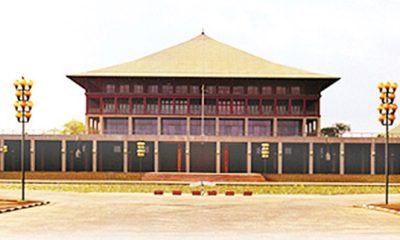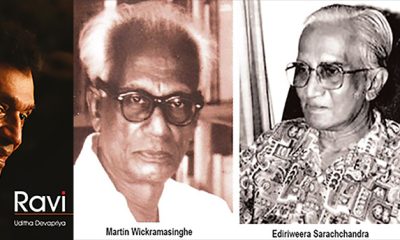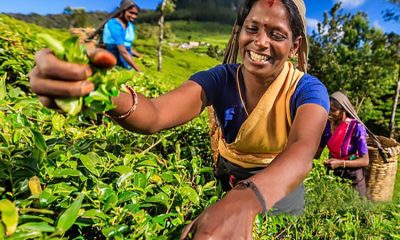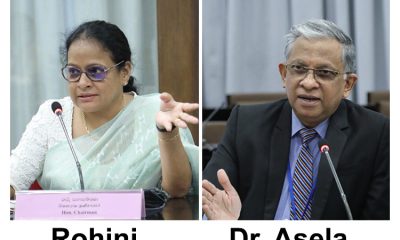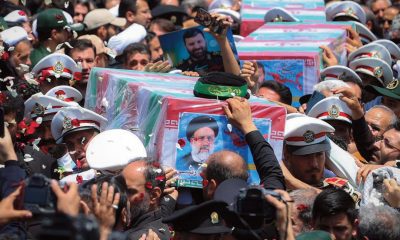Features
In Sri Lanka opposition parties remain as fragmented as ever

By Uditha Devapriya and Rumeth Jayasinghe
Like most South Asian countries, Sri Lanka will face elections this year. Both the government and the Opposition are busy preparing themselves for polls.Presidential elections are expected to take place in September or October 2024, though timelines have not been announced yet. Some analysts believe general elections will follow a presidential election, while others believe they will precede it.
The island nation, which faced its worst economic crisis in 2022, has managed to bring about some stability – though politically and economically, this stability remains fragile, if deceptive, certainly superficial.
The government, headed by Ranil Wickremesinghe, has seemingly managed to get things back in order. The country has imposed on itself several painful austerity measures, with assistance from the IMF, World Bank, and Asian Development Bank, in addition to support from other countries, including India.
Since 2022, Sri Lanka’s economy has seemingly fared well. The country managed to secure an agreement with the IMF on an Extended Fund Facility (EFF) programme in 2023. While the economy grew by 1.6 percent in the third quarter of 2023, inflation, which stood at 56 percent in December 2022, came down to 4.2 percent a year later.
However, while the situation has improved on some fronts, political uncertainty looms large over the island, as policy decisions have fuelled polarisation nearly everywhere. They have also ruptured conventional political divisions and patterns.
So far, Sri Lanka has made progress on restructuring bilateral debt of around USD 11 billion. It expects to come into an agreement with private creditors and bondholders, though the latter remain cautious if not wary.
One of Sri Lanka’s main pillars, tourism, has achieved much growth. Tourist arrivals surged from 194,495 in 2021 to 1,487,303 in 2023, partly due to an ambitious tourism promotional campaign which involved a prominent international influencer.
Once starved of tourists, the country is now witnessing an explosion in hotel bookings, well beyond existing capacity. Indeed, in a strange twist, the Department of Immigration and Emigration recently issued a notification requesting Russian and Ukrainian tourists to leave the island within 14 days, due to nationals of these countries setting up businesses at the expense of locals. A “White Only” party in the south organised in a Russian cafe had aggravated the situation. This is a far cry from 2021 and 2022, when the government was virtually begging for tourists.
However, while there have been improvements in these sectors, they are seen as benefiting a certain privileged class. The Opposition and sections of the public have opposed the government’s economic reforms, including the restructuring of the country’s State-Owned Enterprises (SOEs), which is expected to be completed shortly.
Tax reforms have also garnered criticism. Recent hikes in income and Value Added Taxes have imposed a huge burden on the country’s lower and middle-classes, including professionals and small and medium business owners.
Not surprisingly, these have polarised politics in Sri Lanka. They have been fuelled by the regime’s lurch towards authoritarianism. The recent Online Safety Act, for instance, has sparked criticism from civil society. Scandals, particularly one involving a former Health Minister, who has since been remanded, have taken centre stage.
All these have made the government more vulnerable. Yet far from bolstering unity within the Opposition, the Opposition remains as fragmented as ever.
The Main Opposition: Samagi Jana Balawegaya
The country’s main Opposition Samagi Jana Balavegaya, performed modestly at general elections in 2020, gaining 23.92 percent of the vote. Its leader, Sajith Premadasa, once an ally of Ranil Wickremesinghe, has become a fierce critic of his government.
Capitalising on widespread discontent, his party has vowed to reverse many of the policies being enforced by the government. Yet the SJB faces a tricky situation. On the one hand, as the main Opposition, it has organised numerous protests against the regime’s austerity measures and tax hikes. On the other hand, many of its MPs have aligned themselves with the economic ideology underpinning those reforms.
A recently unveiled economic policy document states that the party supports engagement with the IMF. This has led leftwing MPs to accuse the SJB of being no different to the government. The SJB, in turn, has accused these MPs of being “clueless” with regard to economic reforms, fuelling further divisions within the Opposition.
Complicating matters further, the party has invited to its fold several individuals who were associated with the Gotabaya Rajapaksa government. These include ex-military officials. The party itself is chaired by a former Army Commander, Sarath Fonseka. The inclusion of ex-SLPP stalwarts has driven a wedge between him and Sajith Premadasa, to a point where he is now touting himself as a presidential candidate in his own right.
Swinging to the Left: National People’s Power (NPP)
Widely seen as the most popular party in Sri Lanka, the National People’s Power is tipped to be a frontrunner at upcoming elections.
More than any other political outfit, it is the NPP that has tapped into public discontent with the government. It has based its campaign on promises of eradicating corruption. This, of course, was one of the themes of the protests that drove Gotabaya Rajapaksa out of power. It continues to resonate with the country’s youth, the peasantry, and the working classes, vast swathes of whom have swung to the Left.
Ideologically, the party is seen as favouring public ownership, State-led industrialisation, and nationalisation. It is fiercely opposed to ongoing reforms. Its stance on debt restructuring, though, remains less than clear. While it is opposed to the austerity that restructuring has imposed on the middle and lower classes, it has stated that upon coming to power it will renegotiate, not abandon, the IMF agreement. The IMF itself met with its MPs last January. Details of the meeting, however, have not been released.
The NPP is the parliamentary wing of the Janatha Vimukthi Peramuna, which was formed in the 1960s as an anti-establishment outfit, in opposition even to the mainstream Left. At the height of the country’s ethnic conflict in the 1980s, it was banned by the then government. This pushed it out of the democratic mainstream, leading to a protracted insurrection which was motivated, and driven, by Indian intervention in the country.
Since entering democratic politics in the 1990s, the JVP has softened its stances, though on several issues – especially the India-imposed 13th Amendment – it remains of the same opinion as before. It frequently denounces mainstream political parties, though it too was part of coalition politics. Yet it is seen by the country’s youth and lower middle-classes as being clean and free of corruption, a cut above the rest.
In that sense, the Indian government’s decision to invite the NPP to Delhi, where the party delegation met External Affairs Minister S. Jaishankar, affirms their growing importance not just at home, but also abroad.
Minority Politics: ITAK
The success of these parties will depend a lot on the alliances it forges with other parties. Though nationalism, particularly Sinhala Buddhist nationalism, has played a major part in elections in Sri Lanka, almost all parties have dallied with minority outfits. In 2019, for instance, the SLPP openly courted Muslim votes, even in the backdrop of the Easter attacks, while the UNP secured support from the country’s main Tamil party.
Since the 2020 general election, however, there has been a seismic shift in minority politics. This has been especially evident in Tamil politics. The biggest Tamil political party, the Ilankai Tamil Arasu Kachchi (ITAK), recently witnessed a change in its leadership, from a figure seen as a moderate to a more militant hardliner.
This prefigures a pivotal shift in the tactics of Tamil parties. Earlier, minority parties pursued negotiations with major parties with the objective of obtaining concessions on issues like devolution of power and, in the country’s Northern Province, the return of lands owned by the military to their previous owners.
The situation has changed dramatically today. At the last general election, ITAK retained its dominant position in the Northern Province. Yet two rival parties – the Tamil National People’s Front (TNPF), formed in 2010, and the Tamil People’s National Alliance (TPNA), formed in 2020 – secured enough seats to enter parliament. Both have gone beyond the ITAK’s politics of compromise, advocating for autonomy for Tamils.
S. Sridharan, the ITAK’s new leader, is a fitting symbol of these shifts. Described by the press as a “hardline apologist of the LTTE” – the separatist outfit that waged a war against the Sri Lankan government for 30 years – Sridharan has insisted on a new and more viable solution to the problems of his community.
One of the first things he did as party leader was to visit a cemetery for LTTE cadres in Jaffna. Since then, he has expressed reservations about the 13th Amendment and highlighted the need to go beyond devolution of power. Like his counterparts in other Tamil parties, he has pushed for a federal State. Crucially, he has stated he will do all he can to mobilise Tamil nationalist forces “as they were before 2009”, that is, before the LTTE’s military defeat at the hands of the Sri Lankan government.
So far, neither the government nor the Opposition – be it SJB or NPP – has responded to Sridharan’s calls. Yet alliances with minority parties have become a sine qua non of Sri Lankan politics. It is hence likely that government and Opposition will vie for minority votes through these parties closer to the election.
However, at a time when Sinhala dominated parties from both sides are mobilising nationalist sentiments against one another, it remains to be seen how far they will go to court minorities. While the President himself has made overtures to ITAK, convening a meeting, of Buddhist monks and members of the Tamil diaspora, Sridharan’s victory signals a rupture in minority politics in the island. In the long term, that will dampen prospects of a rapprochement between Tamil parties and the government.
The situation is the same with the Opposition. Both the SJB and NPP are courting disaffected voters from the SLPP camp. Some of these groups, such as ex-army officials, disagree heavily with the politics and ideologies of parties like the ITAK.
The Opposition faces a dilemma here. On the one hand, these groups can help erode the SLPP’s hold over nationalist votes. On the other hand, they can also erode the Opposition’s prospects within minority communities. While it is unlikely that minority parties will fully give up cohabiting with mainstream outfits, the SJB’s and NPP’s reaching out to ex-military types may cost both parties support from outfits like ITAK.
The Future: A (Very) Big Question Mark
Described as Asia’s oldest democracy, Sri Lanka faces a rather tricky crossroads this year. With rising tensions in the Indo-Pacific and the prospect of a forever war in the Middle-East, the island’s domestic politics will shape its foreign policy.
Of course, it is economics, not foreign policy, that has taken centre-stage for now. The big question on everyone’s lips is when Sri Lanka will begin to recover.
Such questions, however, cannot be answered or resolved easily.
Different parties have proposed and presented different solutions to Sri Lanka’s economic crisis. At the centre of it all is one issue. For how long can the country continue inflicting austerity on itself, and for how long can the government survive?
Colombo-based economists argue that IMF reforms should be continued and amplified. Yet the backlash those reforms have generated will be picked up by Opposition parties – even those which are fundamentally in agreement with them.
Thus, while the leader of the SJB has publicly stated that he will renegotiate Sri Lanka’s agreement with the IMF if he comes into power, party MPs have advocated for careful engagement with the IMF. Such contradictions are natural in a country where parties face different electorates and try to pander to all of them.
As for the government, it seems content in churning out narratives of stability. This is a line few people seem to be buying. While the situation has changed from what it was in 2022 – there are no miles-long queues for fuel and gas – that offers little consolation in light of the price and tax hikes which most people have had to put up with.
The situation has become so divisive, in fact, that a video of US Assistant Secretary of State for South and Central Asian Affairs Donald Lu describing Sri Lanka as a comeback story provoked outrage across social media, with several Sri Lankans questioning how he could remain indifferent to, and ignorant of, ground realities.
Against such a backdrop, it is difficult to say who will win elections and what the winner will do with the country. Certainly, the NPP has gained ground, while the SJB’s confused response to economic reforms has cost it popular support. Yet the NPP remains derided by mainstream parties, including the Opposition.
Critically, none of the three major parties battling for votes – SLPP, SJB, and NPP – has fully reached out to minority parties, in particular to Tamil parties.
The SLPP and SJB have, to be sure, forged alliances with certain groups. This is far from the case with the NPP. The NPP has so far been content in promoting its corruption-free record everywhere. The question is how effective such messaging will be with voters in the island’s North and East who have traditionally supported communal parties.
To be sure, it must be admitted that disaffection with the mainstream has grown so much that people are shifting to the Left, particularly to the NPP. To a considerable extent, this disaffection has cut across ethnic and religious divisions.
Whether that will translate into votes, of course, remains to be seen. But it has certainly boosted the NPP’s prospects. This has made it a clear frontrunner, in an election that is sure to be dominated by much uncertainty, chaos, and speculation.
Uditha Devapriya is a writer, researcher, and analyst based in Sri Lanka who contributes to a number of publications on topics such as history, art and culture, politics, and foreign policy. He can be reached at .
Rumeth Jayasinghe is an undergraduate at the University of Peradeniya who is pursuing economics. He can be reached at .
A version of this article was published in The Diplomat.
Features
The heart-friendly health minister

by Dr Gotabhya Ranasinghe
Senior Consultant Cardiologist
National Hospital Sri Lanka
When we sought a meeting with Hon Dr. Ramesh Pathirana, Minister of Health, he graciously cleared his busy schedule to accommodate us. Renowned for his attentive listening and deep understanding, Minister Pathirana is dedicated to advancing the health sector. His openness and transparency exemplify the qualities of an exemplary politician and minister.
Dr. Palitha Mahipala, the current Health Secretary, demonstrates both commendable enthusiasm and unwavering support. This combination of attributes makes him a highly compatible colleague for the esteemed Minister of Health.
Our discussion centered on a project that has been in the works for the past 30 years, one that no other minister had managed to advance.
Minister Pathirana, however, recognized the project’s significance and its potential to revolutionize care for heart patients.
The project involves the construction of a state-of-the-art facility at the premises of the National Hospital Colombo. The project’s location within the premises of the National Hospital underscores its importance and relevance to the healthcare infrastructure of the nation.
This facility will include a cardiology building and a tertiary care center, equipped with the latest technology to handle and treat all types of heart-related conditions and surgeries.
Securing funding was a major milestone for this initiative. Minister Pathirana successfully obtained approval for a $40 billion loan from the Asian Development Bank. With the funding in place, the foundation stone is scheduled to be laid in September this year, and construction will begin in January 2025.
This project guarantees a consistent and uninterrupted supply of stents and related medications for heart patients. As a result, patients will have timely access to essential medical supplies during their treatment and recovery. By securing these critical resources, the project aims to enhance patient outcomes, minimize treatment delays, and maintain the highest standards of cardiac care.
Upon its fruition, this monumental building will serve as a beacon of hope and healing, symbolizing the unwavering dedication to improving patient outcomes and fostering a healthier society.We anticipate a future marked by significant progress and positive outcomes in Sri Lanka’s cardiovascular treatment landscape within the foreseeable timeframe.
Features
A LOVING TRIBUTE TO JESUIT FR. ALOYSIUS PIERIS ON HIS 90th BIRTHDAY

by Fr. Emmanuel Fernando, OMI
Jesuit Fr. Aloysius Pieris (affectionately called Fr. Aloy) celebrated his 90th birthday on April 9, 2024 and I, as the editor of our Oblate Journal, THE MISSIONARY OBLATE had gone to press by that time. Immediately I decided to publish an article, appreciating the untiring selfless services he continues to offer for inter-Faith dialogue, the renewal of the Catholic Church, his concern for the poor and the suffering Sri Lankan masses and to me, the present writer.
It was in 1988, when I was appointed Director of the Oblate Scholastics at Ampitiya by the then Oblate Provincial Fr. Anselm Silva, that I came to know Fr. Aloy more closely. Knowing well his expertise in matters spiritual, theological, Indological and pastoral, and with the collaborative spirit of my companion-formators, our Oblate Scholastics were sent to Tulana, the Research and Encounter Centre, Kelaniya, of which he is the Founder-Director, for ‘exposure-programmes’ on matters spiritual, biblical, theological and pastoral. Some of these dimensions according to my view and that of my companion-formators, were not available at the National Seminary, Ampitiya.
Ever since that time, our Oblate formators/ accompaniers at the Oblate Scholasticate, Ampitiya , have continued to send our Oblate Scholastics to Tulana Centre for deepening their insights and convictions regarding matters needed to serve the people in today’s context. Fr. Aloy also had tried very enthusiastically with the Oblate team headed by Frs. Oswald Firth and Clement Waidyasekara to begin a Theologate, directed by the Religious Congregations in Sri Lanka, for the contextual formation/ accompaniment of their members. It should very well be a desired goal of the Leaders / Provincials of the Religious Congregations.
Besides being a formator/accompanier at the Oblate Scholasticate, I was entrusted also with the task of editing and publishing our Oblate journal, ‘The Missionary Oblate’. To maintain the quality of the journal I continue to depend on Fr. Aloy for his thought-provoking and stimulating articles on Biblical Spirituality, Biblical Theology and Ecclesiology. I am very grateful to him for his generous assistance. Of late, his writings on renewal of the Church, initiated by Pope St. John XX111 and continued by Pope Francis through the Synodal path, published in our Oblate journal, enable our readers to focus their attention also on the needed renewal in the Catholic Church in Sri Lanka. Fr. Aloy appreciated very much the Synodal path adopted by the Jesuit Pope Francis for the renewal of the Church, rooted very much on prayerful discernment. In my Religious and presbyteral life, Fr.Aloy continues to be my spiritual animator / guide and ongoing formator / acccompanier.
Fr. Aloysius Pieris, BA Hons (Lond), LPh (SHC, India), STL (PFT, Naples), PhD (SLU/VC), ThD (Tilburg), D.Ltt (KU), has been one of the eminent Asian theologians well recognized internationally and one who has lectured and held visiting chairs in many universities both in the West and in the East. Many members of Religious Congregations from Asian countries have benefited from his lectures and guidance in the East Asian Pastoral Institute (EAPI) in Manila, Philippines. He had been a Theologian consulted by the Federation of Asian Bishops’ Conferences for many years. During his professorship at the Gregorian University in Rome, he was called to be a member of a special group of advisers on other religions consulted by Pope Paul VI.
Fr. Aloy is the author of more than 30 books and well over 500 Research Papers. Some of his books and articles have been translated and published in several countries. Among those books, one can find the following: 1) The Genesis of an Asian Theology of Liberation (An Autobiographical Excursus on the Art of Theologising in Asia, 2) An Asian Theology of Liberation, 3) Providential Timeliness of Vatican 11 (a long-overdue halt to a scandalous millennium, 4) Give Vatican 11 a chance, 5) Leadership in the Church, 6) Relishing our faith in working for justice (Themes for study and discussion), 7) A Message meant mainly, not exclusively for Jesuits (Background information necessary for helping Francis renew the Church), 8) Lent in Lanka (Reflections and Resolutions, 9) Love meets wisdom (A Christian Experience of Buddhism, 10) Fire and Water 11) God’s Reign for God’s poor, 12) Our Unhiddden Agenda (How we Jesuits work, pray and form our men). He is also the Editor of two journals, Vagdevi, Journal of Religious Reflection and Dialogue, New Series.
Fr. Aloy has a BA in Pali and Sanskrit from the University of London and a Ph.D in Buddhist Philosophy from the University of Sri Lankan, Vidyodaya Campus. On Nov. 23, 2019, he was awarded the prestigious honorary Doctorate of Literature (D.Litt) by the Chancellor of the University of Kelaniya, the Most Venerable Welamitiyawe Dharmakirthi Sri Kusala Dhamma Thera.
Fr. Aloy continues to be a promoter of Gospel values and virtues. Justice as a constitutive dimension of love and social concern for the downtrodden masses are very much noted in his life and work. He had very much appreciated the commitment of the late Fr. Joseph (Joe) Fernando, the National Director of the Social and Economic Centre (SEDEC) for the poor.
In Sri Lanka, a few religious Congregations – the Good Shepherd Sisters, the Christian Brothers, the Marist Brothers and the Oblates – have invited him to animate their members especially during their Provincial Congresses, Chapters and International Conferences. The mainline Christian Churches also have sought his advice and followed his seminars. I, for one, regret very much, that the Sri Lankan authorities of the Catholic Church –today’s Hierarchy—- have not sought Fr.
Aloy’s expertise for the renewal of the Catholic Church in Sri Lanka and thus have not benefited from the immense store of wisdom and insight that he can offer to our local Church while the Sri Lankan bishops who governed the Catholic church in the immediate aftermath of the Second Vatican Council (Edmund Fernando OMI, Anthony de Saram, Leo Nanayakkara OSB, Frank Marcus Fernando, Paul Perera,) visited him and consulted him on many matters. Among the Tamil Bishops, Bishop Rayappu Joseph was keeping close contact with him and Bishop J. Deogupillai hosted him and his team visiting him after the horrible Black July massacre of Tamils.
Features
A fairy tale, success or debacle

Sri Lanka-Singapore Free Trade Agreement
By Gomi Senadhira
senadhiragomi@gmail.com
“You might tell fairy tales, but the progress of a country cannot be achieved through such narratives. A country cannot be developed by making false promises. The country moved backward because of the electoral promises made by political parties throughout time. We have witnessed that the ultimate result of this is the country becoming bankrupt. Unfortunately, many segments of the population have not come to realize this yet.” – President Ranil Wickremesinghe, 2024 Budget speech
Any Sri Lankan would agree with the above words of President Wickremesinghe on the false promises our politicians and officials make and the fairy tales they narrate which bankrupted this country. So, to understand this, let’s look at one such fairy tale with lots of false promises; Ranil Wickremesinghe’s greatest achievement in the area of international trade and investment promotion during the Yahapalana period, Sri Lanka-Singapore Free Trade Agreement (SLSFTA).
It is appropriate and timely to do it now as Finance Minister Wickremesinghe has just presented to parliament a bill on the National Policy on Economic Transformation which includes the establishment of an Office for International Trade and the Sri Lanka Institute of Economics and International Trade.
Was SLSFTA a “Cleverly negotiated Free Trade Agreement” as stated by the (former) Minister of Development Strategies and International Trade Malik Samarawickrama during the Parliamentary Debate on the SLSFTA in July 2018, or a colossal blunder covered up with lies, false promises, and fairy tales? After SLSFTA was signed there were a number of fairy tales published on this agreement by the Ministry of Development Strategies and International, Institute of Policy Studies, and others.
However, for this article, I would like to limit my comments to the speech by Minister Samarawickrama during the Parliamentary Debate, and the two most important areas in the agreement which were covered up with lies, fairy tales, and false promises, namely: revenue loss for Sri Lanka and Investment from Singapore. On the other important area, “Waste products dumping” I do not want to comment here as I have written extensively on the issue.
1. The revenue loss
During the Parliamentary Debate in July 2018, Minister Samarawickrama stated “…. let me reiterate that this FTA with Singapore has been very cleverly negotiated by us…. The liberalisation programme under this FTA has been carefully designed to have the least impact on domestic industry and revenue collection. We have included all revenue sensitive items in the negative list of items which will not be subject to removal of tariff. Therefore, 97.8% revenue from Customs duty is protected. Our tariff liberalisation will take place over a period of 12-15 years! In fact, the revenue earned through tariffs on goods imported from Singapore last year was Rs. 35 billion.
The revenue loss for over the next 15 years due to the FTA is only Rs. 733 million– which when annualised, on average, is just Rs. 51 million. That is just 0.14% per year! So anyone who claims the Singapore FTA causes revenue loss to the Government cannot do basic arithmetic! Mr. Speaker, in conclusion, I call on my fellow members of this House – don’t mislead the public with baseless criticism that is not grounded in facts. Don’t look at petty politics and use these issues for your own political survival.”
I was surprised to read the minister’s speech because an article published in January 2018 in “The Straits Times“, based on information released by the Singaporean Negotiators stated, “…. With the FTA, tariff savings for Singapore exports are estimated to hit $10 million annually“.
As the annual tariff savings (that is the revenue loss for Sri Lanka) calculated by the Singaporean Negotiators, Singaporean $ 10 million (Sri Lankan rupees 1,200 million in 2018) was way above the rupees’ 733 million revenue loss for 15 years estimated by the Sri Lankan negotiators, it was clear to any observer that one of the parties to the agreement had not done the basic arithmetic!
Six years later, according to a report published by “The Morning” newspaper, speaking at the Committee on Public Finance (COPF) on 7th May 2024, Mr Samarawickrama’s chief trade negotiator K.J. Weerasinghehad had admitted “…. that forecasted revenue loss for the Government of Sri Lanka through the Singapore FTA is Rs. 450 million in 2023 and Rs. 1.3 billion in 2024.”
If these numbers are correct, as tariff liberalisation under the SLSFTA has just started, we will pass Rs 2 billion very soon. Then, the question is how Sri Lanka’s trade negotiators made such a colossal blunder. Didn’t they do their basic arithmetic? If they didn’t know how to do basic arithmetic they should have at least done their basic readings. For example, the headline of the article published in The Straits Times in January 2018 was “Singapore, Sri Lanka sign FTA, annual savings of $10m expected”.
Anyway, as Sri Lanka’s chief negotiator reiterated at the COPF meeting that “…. since 99% of the tariffs in Singapore have zero rates of duty, Sri Lanka has agreed on 80% tariff liberalisation over a period of 15 years while expecting Singapore investments to address the imbalance in trade,” let’s turn towards investment.
Investment from Singapore
In July 2018, speaking during the Parliamentary Debate on the FTA this is what Minister Malik Samarawickrama stated on investment from Singapore, “Already, thanks to this FTA, in just the past two-and-a-half months since the agreement came into effect we have received a proposal from Singapore for investment amounting to $ 14.8 billion in an oil refinery for export of petroleum products. In addition, we have proposals for a steel manufacturing plant for exports ($ 1 billion investment), flour milling plant ($ 50 million), sugar refinery ($ 200 million). This adds up to more than $ 16.05 billion in the pipeline on these projects alone.
And all of these projects will create thousands of more jobs for our people. In principle approval has already been granted by the BOI and the investors are awaiting the release of land the environmental approvals to commence the project.
I request the Opposition and those with vested interests to change their narrow-minded thinking and join us to develop our country. We must always look at what is best for the whole community, not just the few who may oppose. We owe it to our people to courageously take decisions that will change their lives for the better.”
According to the media report I quoted earlier, speaking at the Committee on Public Finance (COPF) Chief Negotiator Weerasinghe has admitted that Sri Lanka was not happy with overall Singapore investments that have come in the past few years in return for the trade liberalisation under the Singapore-Sri Lanka Free Trade Agreement. He has added that between 2021 and 2023 the total investment from Singapore had been around $162 million!
What happened to those projects worth $16 billion negotiated, thanks to the SLSFTA, in just the two-and-a-half months after the agreement came into effect and approved by the BOI? I do not know about the steel manufacturing plant for exports ($ 1 billion investment), flour milling plant ($ 50 million) and sugar refinery ($ 200 million).
However, story of the multibillion-dollar investment in the Petroleum Refinery unfolded in a manner that would qualify it as the best fairy tale with false promises presented by our politicians and the officials, prior to 2019 elections.
Though many Sri Lankans got to know, through the media which repeatedly highlighted a plethora of issues surrounding the project and the questionable credentials of the Singaporean investor, the construction work on the Mirrijiwela Oil Refinery along with the cement factory began on the24th of March 2019 with a bang and Minister Ranil Wickremesinghe and his ministers along with the foreign and local dignitaries laid the foundation stones.
That was few months before the 2019 Presidential elections. Inaugurating the construction work Prime Minister Ranil Wickremesinghe said the projects will create thousands of job opportunities in the area and surrounding districts.
The oil refinery, which was to be built over 200 acres of land, with the capacity to refine 200,000 barrels of crude oil per day, was to generate US$7 billion of exports and create 1,500 direct and 3,000 indirect jobs. The construction of the refinery was to be completed in 44 months. Four years later, in August 2023 the Cabinet of Ministers approved the proposal presented by President Ranil Wickremesinghe to cancel the agreement with the investors of the refinery as the project has not been implemented! Can they explain to the country how much money was wasted to produce that fairy tale?
It is obvious that the President, ministers, and officials had made huge blunders and had deliberately misled the public and the parliament on the revenue loss and potential investment from SLSFTA with fairy tales and false promises.
As the president himself said, a country cannot be developed by making false promises or with fairy tales and these false promises and fairy tales had bankrupted the country. “Unfortunately, many segments of the population have not come to realize this yet”.
(The writer, a specialist and an activist on trade and development issues . )



